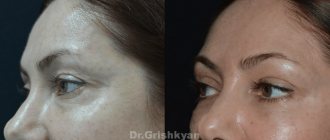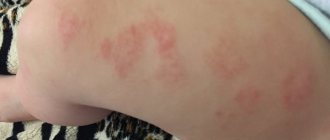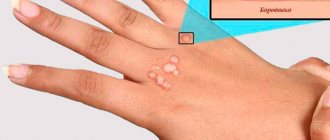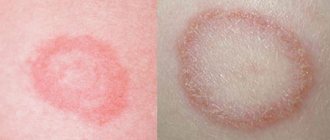What diseases do skin redness indicate?
It would probably be superfluous to say that the most common pathologies associated with redness of the skin in children are a consequence of allergies. Parents are able to draw a “parallel” and, using the method of exclusion, determine what products, washing powder, clothes, etc. the reaction occurs to.
- Quite often, red skin in a child is a consequence of a viral infection. In the initial phase of development, many diseases appear as red spots. Subsequently, the clinical picture of the disease is supplemented with new symptoms. For example, with the rubella virus and chickenpox.
- With skin rashes caused by bacterial infections, such as pyoderma or coccal infections, red spots also appear in the early period of the disease.
- Among dermatological diseases, the most common are hereditary psoriasis and similar eczema.
- Characteristic signs of fungal infections, autoimmune lupus and focal scleroderma appear in the form of skin redness and spots.
- Red spots on a child’s skin often appear due to neurological diseases. Caused by stressful situations, temperature changes and sudden changes in environment.
This list is far from complete. Here you can add meningitis, hepatitis, scarlet fever and many other diseases. Often, the pathology is associated with underlying diseases - renal, pancreatic and intestinal disorders. May be a consequence of genetic predisposition. Therefore, in order not to provoke the disease, you should not diagnose and treat skin redness yourself.
Read also: Allergies in children
How does seborrheic dermatitis manifest in adolescents?
Foci of inflammation appear primarily on the face: on the nose, forehead, around the eyes, as well as on the chest and between the shoulder blades, on the scalp. In all these areas there are a large number of sebaceous glands, and it is because of disturbances in their work that seborrhea develops. The causative agent of seborrheic dermatitis is considered to be a fungus from the Malassezia family, which feeds on fatty acids that are part of the secretions from the sebaceous glands. It is part of the natural human microflora. When the body works normally, the amount of fungus does not threaten health. But when the balance is disrupted, the functioning of the sebaceous glands changes, and the fungus begins to actively develop and cause harm.
Types of seborrhea in adolescents:
- oily: with increased sebum secretion, acne appears, skin and hair become greasy;
- dry: sebum production decreases, pores narrow, which also causes acne, comedones, and dandruff to appear on the head.
In some cases, seborrheic dermatitis is mixed.
Symptoms of seborrheic dermatitis:
- skin irritation accompanied by itching, swelling, redness;
- peeling, which can be very intense;
- acne in large quantities;
- painful sensations on the skin, especially when touched.
In the absence of proper care and treatment, skin scales constantly flake off, and the skin underneath becomes red and wet. If you scratch the inflamed areas, it causes pain, leads to scratches and microtraumas, through which secondary infection occurs.
On the scalp, flaking leads to dandruff.
Who to contact and what to do?
Due to the variety of causative factors, the child should be examined and treated by a doctor of a narrow specialization. This could be a pediatrician, pediatric dermatologist, allergist, or other specialists, based on examination and diagnostic indications. What can parents do?
If your child's skin turns red, you should refrain from bathing the child before you see a doctor. If the nature of the redness is fungal, bacterial or viral, bathing can spread the infection and affect large areas of the skin.
Redness caused by allergies can be relieved by eliminating possible causes. There should be: a balanced diet, avoiding contact with animals and objects that can provoke an allergic reaction.
For prickly heat, special herbal decoctions should be added to the bath water. Replace baby cream with powder. You can stop the burning and itching after an insect bite with a light solution of vinegar or soda solution.
What happens if seborrhea in teenagers is not treated?
Often, when skin problems appear during puberty, parents think that they will go away on their own with time. Yes, sometimes that happens. But often teenage seborrhea becomes chronic, from which a person suffers throughout his life.
The consequences of seborrheic dermatitis can be eczematous conditions and severe forms of acne. If seborrheic manifestations are localized on the head, this leads over time to hair loss and even baldness. If the dermatitis affects the area around the ears, it can spread inward and lead to ear infections.
Does your child need specialist help?
You can make an appointment with a doctor by phone
8-(4822)-33-00-33
or using the online registration system on the website
To make an appointment with a doctor
Preventive measures
Basic rules of prevention:
- hygiene and proper child care;
- free access of air to the affected areas of the skin;
- exclude contact of the child with the carrier of the infection;
- When breastfeeding, a mother should consider her diet.
Compliance with all norms and rules will avoid complicated processes and relapses.
Dear parents!
Remember that only a qualified pediatrician can make an accurate diagnosis, determine the causes and nature of the disease, and prescribe effective treatment. You can make an appointment with our specialists or call a doctor at home by calling 8-800-700-31-69 Grow up healthy and happy!
Treatment of seborrheic dermatitis in adolescents
If the cause of seborrhea in a teenager is diseases of internal organs, disruptions in the functioning of body systems, then it is necessary to treat or at least stabilize them. Otherwise, the fight against seborrhea will be ineffective.
If there are no serious health problems, to treat seborrhea you need to carefully care for your skin and use specialized products for this.
Since the main cause of seborrheic dermatitis is an increase in yeast, it is necessary to combat it. For this you need antifungal drugs. These are medicated shampoos and gels, creams. They may have different active substances, for example, ketoconazole or sodium sulfide. The main thing is that they reduce the activity of the fungus and reduce its quantity. Such drugs are applied topically, that is, directly to the skin affected by the fungus. The frequency of application is in accordance with the instructions, but usually it is 1-3 times a week during the entire period of therapy, and after improvement of the condition - once a week to maintain the effect and prevention. Creams and gels are applied for absorption and do not wash off. And shampoos are applied and left for at least 5 minutes so that they have time to be absorbed into the skin and hair, and only then washed off.
There are entire lines of skin care products for seborrheic dermatitis on sale. For example, preparations from the Sulsen series contain selenium disulfide, which suppresses the activity of the fungus Pityrosporum Ovale and restores the balance of the scalp. The series includes shampoo, peeling, paste, cream, oil. You can choose hair care products for both boys and girls. They can be used from the age of 14 and are suitable for teenagers. They have a natural composition and do not cause allergies. The products are used twice a week. Typically, seborrheic symptoms disappear within a month, but you can use these drugs longer - until the effect is achieved, and then once every 1 - 2 weeks for prevention.
Skin rashes on babies: causes, treatment and prevention
In the first months of life, babies are prone to various types of irritation and rashes on parts of their body. This phenomenon is quite normal and in most cases is considered normal. This is due to the fact that the baby’s body is still very vulnerable, and it is just beginning to adapt to external and internal factors that can negatively affect the child’s condition. In addition, up to two or three months the baby is faced with hormonal changes, which often causes similar reactions. Consequently, a rash is not always a cause for concern and panic, but a specialist can best determine the nature of its occurrence and methods of treatment. There are a number of reasons that provoke the appearance of pimples, spots or redness on the skin of a newborn:
- hormonal rash;
- prickly heat;
- dermatitis;
- hives;
- food allergies;
- infections and viruses.
In 70% of cases, the rash occurs precisely on a hormonal background, which is completely normal and does not require treatment, especially medication. This is due to the receipt of maternal hormones while still in the womb, and subsequent adaptation to new conditions. Distributes on the forehead, temples, and on the back of the head under the hair. It goes away on its own, usually within a few days. In this case, the mother is recommended to simply bathe the baby daily in boiled water with the addition of a herbal solution (series). During the hot season, the baby’s delicate skin is doubly prone to various manifestations due to drying out in the sun. All areas exposed to sweat also become vulnerable. Miliaria is not life-threatening for the baby, but it can cause discomfort in the places where it is localized. You should bathe your child more often, ventilate the room, and, if possible, maintain optimal humidity where the baby spends most of his time. Of course, you should not dress your child in clothes that will make him hot and uncomfortable. It is useful to give the baby time to be without clothes and diapers so that the skin has the opportunity to breathe. In addition, it is recommended to always wash small items only using a special children's powder, and then iron them on both sides.
Skin rashes on babies: causes, treatment and prevention
In the first months of life, babies are prone to various types of irritation and rashes on parts of their body. This phenomenon is quite normal and in most cases is considered normal. This is due to the fact that the baby’s body is still very vulnerable, and it is just beginning to adapt to external and internal factors that can negatively affect the child’s condition. In addition, up to two or three months the baby is faced with hormonal changes, which often causes similar reactions. Consequently, a rash is not always a cause for concern and panic, but a specialist can best determine the nature of its occurrence and methods of treatment. There are a number of reasons that provoke the appearance of pimples, spots or redness on the skin of a newborn:
- hormonal rash;
- prickly heat;
- dermatitis;
- hives;
- food allergies;
- infections and viruses.
In 70% of cases, the rash occurs precisely on a hormonal background, which is completely normal and does not require treatment, especially medication. This is due to the receipt of maternal hormones while still in the womb, and subsequent adaptation to new conditions. Distributes on the forehead, temples, and on the back of the head under the hair. It goes away on its own, usually within a few days. In this case, the mother is recommended to simply bathe the baby daily in boiled water with the addition of a herbal solution (series). During the hot season, the baby’s delicate skin is doubly prone to various manifestations due to drying out in the sun. All areas exposed to sweat also become vulnerable. Miliaria is not life-threatening for the baby, but it can cause discomfort in the places where it is localized. You should bathe your child more often, ventilate the room, and, if possible, maintain optimal humidity where the baby spends most of his time. Of course, you should not dress your child in clothes that will make him hot and uncomfortable. It is useful to give the baby time to be without clothes and diapers so that the skin has the opportunity to breathe. In addition, it is recommended to always wash small items only using a special children's powder, and then iron them on both sides.
Folk remedies
To alleviate the patient’s condition, you can use improvised means, for example, shampoos or ointments containing natural tar. They do not treat seborrheic dermatitis, but suppress excessive proliferation of the stratum corneum of the epidermis.
Tea tree oil has an antifungal and soothing effect. It is applied pointwise to inflamed seborrheic areas of the skin.
Any folk remedies do not treat seborrhea. Herbal infusions, decoctions, and lotions may cause short-term minor improvement in some adolescents, but for most they have no effect. They need to be used constantly, for a long time. And many natural remedies cause allergies, so the skin condition only worsens. They can be used as auxiliary, but not as the basis of treatment. If you rely on traditional medicine and natural remedies, you can waste time, so the recovery will be longer than when you immediately start using special remedies.










